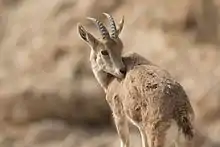Nubian ibex
The Nubian ibex (Capra nubiana) is a desert-dwelling goat species found in mountainous areas of northern and northeast Africa, and the Middle East. Its range is within Algeria, Egypt, Ethiopia, Eritrea, Israel, Jordan, Oman, Saudi Arabia, Sudan, and Yemen. It is extirpated in Lebanon. It is historically considered to be a subspecies of the Alpine ibex (C. ibex), but is increasingly considered a specifically distinct species (C. nubiana). The wild population is estimated at 1,200 individuals.
| Nubian ibex | |
|---|---|
.jpg.webp) | |
| Male | |
.jpg.webp) | |
| Female with kid Both in Israel | |
| Scientific classification | |
| Kingdom: | Animalia |
| Phylum: | Chordata |
| Class: | Mammalia |
| Order: | Artiodactyla |
| Family: | Bovidae |
| Subfamily: | Caprinae |
| Genus: | Capra |
| Species: | C. nubiana |
| Binomial name | |
| Capra nubiana F. Cuvier, 1825 | |
Description
Nubian ibexes stand around 65–75 cm (2.1–2.6 ft) tall at the shoulder and weigh around 50 kg (110 lb). They are a light tan color, with a white underbelly; males also have a dark brown stripe down their backs. Nubian ibexes have long, thin horns that extend up and then backwards and down. In males, these reach around 1 m in length, while in females they are much smaller (around 30 cm (12 in)).[2]
Ecology

Nubian ibexes live in rough, dry, mountainous terrain, where they eat mainly grasses and leaves and are preyed upon by leopards, wolves, common foxes, eagles, and bearded vultures. They are social and herds tend to consist of females, young, and males up to the age of about three years. The males are solitary or form more transitory bands of up to eight individuals. During the breeding season, males join the female-based herds for the six- to eight-week rut. Large males then do battle with much clashing of horns.[2]
Nubian ibexes are diurnal, meaning they are active during the day, and rest at night. On 16 March 1959, the British established the Yob Wildlife Reserve in northern Eritrea specifically to protect significant populations of Nubian ibex in the area.[3][4]
Status
.jpg.webp)
The International Union for Conservation of Nature has classified the Nubian ibex as "vulnerable" on the basis that fewer than 10,000 mature individuals remain and the population is declining. Threats faced by the animal include competition with livestock for water and fodder, hunting pressure, and habitat destruction.[1]
In Israel, the historically dense ibex population, described in the Bible (Psalm 104:18), was decimated in the wake of the First World War when the sudden availability of rifles enabled Bedouin to hunt them to near extinction.[5] After the establishment of the state, when hunting was outlawed and nature reserves were created in which they were protected, the ibex population rebounded. Three ibex populations have been discovered in Israel: in the Judean Desert, the Negev mountains and Eilat.[6]
In popular culture
The Biblical heroine Yael's name means "Ibex" in Hebrew. The Nubian ibex in particular was in the BBC documentary Life, and featured prominently in the popular television documentary series Planet Earth (episode five, "Deserts").[7]
See also
References
| Wikimedia Commons has media related to Capra nubiana. |
- Ross, S.; Elalqamy, H.; Al Said, T. & Saltz, D. (2020). "Capra nubiana". IUCN Red List of Threatened Species. 2020: e.T3796A22143385.
- Jonathan Kingdon; David Happold; Thomas Butynski; Michael Hoffmann; Meredith Happold; Jan Kalina (2013). Mammals of Africa. A&C Black. pp. 600–603. ISBN 978-1-4081-8996-2.
- "Yob Wildlife Reserve". Protectedplanet.net. Retrieved 30 May 2012.
- Shackleton, David M. (1997). Wild Sheep and Goats and Their Relatives: Status Survey and Conservation Action Plan for Caprinae. International Union for Conservation of Nature and Natural Resources. Species Survival Commission. Caprinae Specialist Group. p. 26. ISBN 978-2-8317-0353-4.
- The remarkable return of the ibex; Alon Tal, 16 October 2019, The Times of Israel,
- Conservation saved the ibex but created new dangers, Haaretz
- Produced by Huw Cordey (2 April 2006). "Deserts". Planet Earth. BBC. BBC One.

